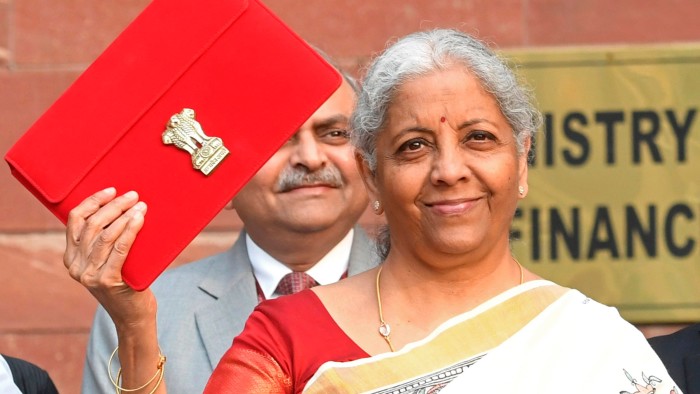Unlock the Editor’s Digest for free
Roula Khalaf, Editor of the FT, selects her favourite stories in this weekly newsletter.
India announced tax breaks for the middle classes and measures meant to improve the ease of doing business as Narendra Modi’s government unveiled its first full-year budget since an economic slowdown that followed his re-election last year.
The sweeteners for middle-income Indians, as well as small and mid-size businesses, came alongside steps aimed at reinvigorating the world’s fifth-biggest economy and reviving demand among urban consumers, a core political base for Modi’s Bharatiya Janata party.
Nirmala Sitharaman, finance minister, on Saturday announced an increase in the personal income tax threshold below which taxpayers owe no tax to Rs1.2mn ($13,842), up from Rs700,000, as well as an uplift in brackets for the rates levied on taxable income. She said that the government would introduce a new income tax bill next week.
The finance minister added that the new rates would “substantially reduce the taxes of the middle class and leave more money in their hands, boosting household consumption, savings and investment”, as ruling coalition MPs chanted “Modi, Modi”.
Among measures meant to make doing business easier, Sitharaman said a high-level committee for regulatory reforms that would review India’s rules, certifications, licences, and permissions governing business as well as the creation of an investment friendliness index of states, would be launched this year.
“A light touch regulatory framework based on principles and trust will unleash productivity and employment,” Sitharaman said.
Business groups have long urged India to reduce onerous paperwork and compliance burdens and reform the rules governing labour and land markets to stimulate investment and create jobs.
“The focus of the budget has, basically, come in consumption via taxation cuts to support lower income and middle income segments of society, because that’s where the pain point has been very visible,” said Madhavi Arora, chief economist at Emkay Global Financial Services in Mumbai.
India has bounced back since the Covid-19 pandemic and remains the world’s fastest-growing big economy, but GDP growth in the second fiscal quarter that ended in September was 5.4 per cent, the slowest in nearly two years.
Despite strong infrastructure spending by the state, private investment has been sluggish and job creation weak. Inflation has been trending near the top of the Reserve Bank of India’s mandated band of 4-6 per cent, limiting its scope to cut lending rates.
Vijayaraghavan Swaminathan, head of research at Avendus Spark Institutional Equities in Chennai, said the government’s intent in announcing the tax cuts was “very clear” and that they would give middle-class households “a breather”.
In a special trading session on Saturday, India’s benchmark Nifty 50 blue-chip index fell 0.5 per cent, though consumer stocks were buoyed by Sitharaman’s moves to lower income tax pressures.
“The market is confused as of now,” said Swaminathan. “A lot of numbers remain to be seen, including how the government is going to accommodate this tax collection hit.”
In India’s annual Economic Survey, published by the government on Friday, the finance ministry painted a stark picture of the challenges faced by the youth and the economy. These included a reliance on China for supply chains serving critical industries such as solar power, advanced batteries and electric vehicles.
The report, authored by Modi’s chief economic adviser V Anantha Nageswaran, also urged India’s central and state governments to “get out of the way” and deregulate the economy or face a “high risk of economic growth stagnation, if not economic stagnation”.
The report forecast real GDP growth of 6.4 per cent for the current fiscal year, down from 8.2 per cent in 2023-4. The government is forecasting growth of 6.3 to 6.8 per cent in the coming 2025-6 fiscal year.
Read the full article here




